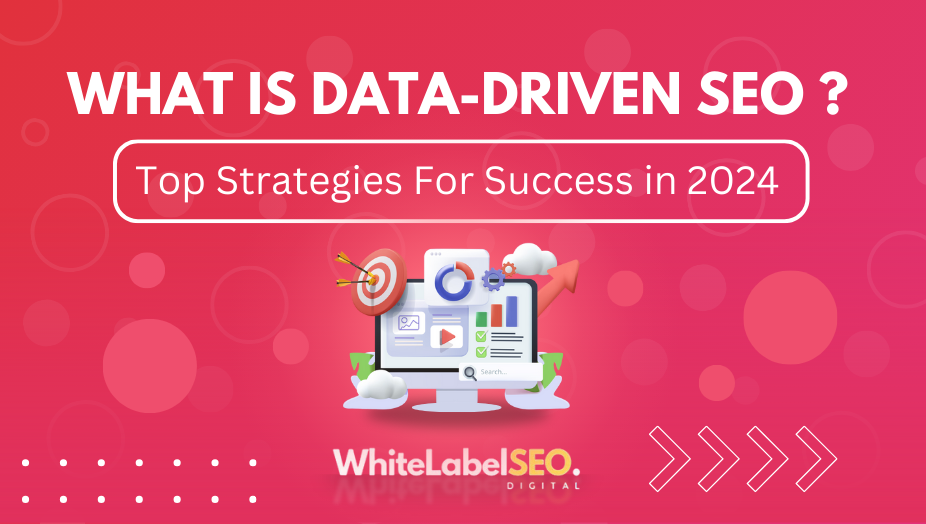
SEO relies heavily on a robust content strategy. In today’s dynamic digital world, data plays a crucial role in optimizing SEO efforts. Data-driven SEO helps in building strategies based on thorough data analysis.
So what is data-driven SEO? This process includes collecting both quantitative and qualitative information to make data-driven decisions and build an effective SEO marketing program. By collecting and analyzing data, you can attract targeted and profitable search traffic.
Data analysis helps marketers identify successful past methods and predict future successes, ensuring strategies are well-informed and effective. Developing data-driven decisions involves using insights from analysis to create the best approach possible.
Integrating data into your strategy allows you to target the right audience and achieve tangible results. The data-driven approach to SEO will keep your efforts competitive and adaptive in the ever-evolving digital landscape.
Understanding what is data-driven SEO is key to optimizing your digital marketing efforts.
SEO Trends in 2024: An Overview of Data-Driven Perspective
A data-driven SEO campaign is crucial for several reasons. It offers insights into consumer behavior, helping businesses refine their strategies. To fully grasp what is data-driven SEO, you need to dive into both quantitative and qualitative data analysis. By analyzing search trends and keywords, companies can optimize their content and website structure to attract more traffic.
Data-driven methods also support continuous improvement. Metrics like bounce rates and conversion rates guide ongoing adjustments for better performance. Ultimately, this approach fosters agility and competitiveness, enabling businesses to stay ahead by using actionable insights for sustained growth and success.
This approach typically involves using various data sources and SEO tools to analyze factors like user search intent, user experience, site traffic performance, technical data, and conversion rates. As a result, SEO experts can –
- Understand user behavior, website performance, and relative internet popularity
- Identify opportunities to refine strategies and make impactful recommendations
- Measure the impact of their efforts and continuously improve search engine performance over time
Positioning the website to gain higher position in search engine results pages for relevant keywords is the end goal.
Top Data-driven SEO Strategies

Data-driven SEO relies on data analysis to guide strategic decisions. This data-driven SEO is an approach that uses insights from data analytics to create marketing strategies that efficiently engage target audiences. Here’s the best way to implement it.
1. Create a Data-Driven Keyword List
Keyword research is usually the first step of any effective strategy. One of the best ways to find keywords that your target customers are searching for is by using Google Suggest. Start typing a keyword into Google’s search field, and it will generate a list of suggestions. These suggestions are great to improve SEO because they come directly from Google, indicating that people are actually searching for them.
Longer keywords, known as “long-tail keywords,” are typically less competitive than “short-tail” terms. While long tails have lower search volume, they are easier to rank for. Knowing what is data-driven SEO allows you to enhance your keyword strategies for better results. The data-driven part is finding the math to automate this process at scale. This is where the concept of clustering keywords comes into play.
Clustering keywords involves comparing the search results between two keywords. If the results are similar, the keywords are considered to have the same search intent and should be mapped to the same content page. The data-driven part is finding the math to automate this process at scale. This can be achieved by –
- Reducing the rank for a keyword on SERPs to a string
- Using a string similarity algorithm to compare the results
- Grouping the results of search of a keyword based on a threshold (example 60%) similarity for similar search intent
You can efficiently identify and target the most relevant keywords for your SEO strategy by following the above steps.
Related – What is SEO Keyword Research in 2024?
2. Analyze Top Google Search Results
Once you have identified a set of keywords, the next step is to analyze who currently appears in the top of SERPs for them. Start by typing one of your chosen keywords into Google and examining the top 10 results. Carefully scan these results and take note of any patterns you observe.
For instance, if the top results for a keyword are mostly list posts, you should consider creating a similar list post for your site. This helps align your content with what Google is currently favoring for that keyword. By understanding the types of content that perform well, you can better tailor your strategy to compete efficiently.
When you ask, what is data-driven SEO, the answer includes continuous improvement based on real-time metrics. This process not only helps you understand the competitive landscape but also guides you in creating content that is more likely to rank well. It will help increase your chances of achieving top positions in the SERPs.
3. Understanding Ranking Factors Through Competitor Analysis
Competitor analysis aims to quantify what factors contribute to the differences in rankings between competitors and your own site. Traditionally, SEOs used spreadsheets or manually analyzed results of the search.
A more data-driven approach involves recognizing that Google rank positions are continuous variables. This means they can vary infinitely. Regression analysis is an ideal option here. It shows how changes in ranking factors lead to proportional changes in Google rank.
These factors can be collected from various sources, such as technical audits for on-site factors or metrics like backlinks for off-site influences. Understanding what is data-driven SEO helps in comparing your site’s performance against competitors’. You can better understand how to improve your site’s SEO performance relative to competitors by analyzing these factors systematically.
4. Split A/B Testing to Mitigate SEO Risks
Implementing technical SEO recommendations can significantly impact revenue, making it crucial to minimize risks. One effective strategy is Split A/B testing, where recommendations are tested on selected pages to assess their impact on organic performance before full implementation.
The process involves-
- Designing the experiment to determine the minimum sample size and how data will be distributed.
- Conducting the experiment by applying the recommendations to the selected pages.
- Evaluating the experiment data from Google Analytics to determine if there is a significant improvement in performance, including conversion rate optimization metrics. This process also helps in addressing technical SEO issues efficiently.
If you are wondering what is data-driven SEO, consider how A/B testing can validate your SEO recommendations. You can make informed decisions about broader implementation by testing changes on a smaller scale first. It reduces the risk of negative impacts on overall performance of SEO campaign.
5. Forecasting Organic Traffic Using Time Series Analysis
Digital marketing managers often want to predict future organic traffic levels, especially for the upcoming year. SEO experts achieve this through time series forecasting techniques, which analyze patterns in historical organic traffic data over various time periods.
These techniques break down the data based on –
Seasonality: Identifying repetitive cycles, whether daily, monthly, weekly, etc.
Trend: Determining the general direction of traffic growth or decline.
Auto-correlation: Assessing how each data point relates to previous points.
The concept of what is data-driven SEO includes using historical data to forecast future traffic trends. Time series models use these factors to filter out noise, making future traffic levels more predictable. However, reliable forecasts require substantial historical data. This approach helps businesses anticipate traffic trends and adjust local SEO strategies accordingly for optimal performance.
Expert Insights
Queries that include phrases like “near me” don’t require you to rank specifically for the term “near me.” This phrase is inherently broad and not directly related to the content on your website. Instead, focus on optimizing for local relevance so that search engines can associate your business with relevant local searches.
6. Create a Unique and Superior Content for SEO
When crafting SEO content, you have two main approaches –
Option 1: Create something unique – Innovate by offering fresh perspectives or original ideas that fill gaps in existing content. Data-driven insights reveal untapped topics or angles that can attract niche audiences and improve search relevance.
Option 2: Create something better – Use data to identify top-performing content in your industry, and then enhance it with more comprehensive research, richer multimedia, or better presentation. This approach, known as The Skyscraper Technique, leverages competitive analysis to ensure your content surpasses competitors in quality and relevance.
A key element of what is data-driven SEO involves creating unique content based on data insights. Both strategies leverage data to make informed content decisions. And this ensures your approach aligns with audience preferences and search engine algorithms for maximum impact.
7. Adding Hook to Generate Backlinks
To boost your position on the search engine, acquiring backlink is crucial – lots of them. Backlinks strongly correlate with top Google rankings, making them an important ranking factor.
But how do you attract a backlink?
It starts with identifying why people link to specific content within your industry – it is termed as the “Hook.” Incorporate it into your own content strategy. By integrating compelling hooks that resonate with your audience, you can increase the likelihood of attracting valuable backlinks, thereby enhancing your site’s authority and prominence on SERPs.
In the context of what is data-driven SEO, integrating compelling hooks can significantly enhance backlink acquisition.
8. Enhancing Content Visibility Through On-Page SEO Optimization
Optimizing your content for on-page SEO is crucial for improving its position on SERPs. Beyond basic optimization, it involves several key techniques that can significantly impact your search rankings. And Internal linking is one of them.
It is a powerful strategy. When done strategically, it involves linking from high-authority web pages to those that need to boost their authority. This helps distribute link equity throughout your site while enhancing the overall SEO performance and visibility of specific pages.
Related – What is Link Equity?
9. Leverage Data for Effective Link Building
Link building in SEO aims to acquire high-quality backlinks from authoritative websites, enhancing your site’s authority and credibility in Google searches. Analyzing data enhances the efficiency of your link-building efforts and provides insights into lucrative backlink opportunities.
There are various tools that help in streamlining the time-consuming outreach process by identifying domains with strong potential for backlinks. This strategic use of data ensures your link-building strategy is targeted and effective, maximizing your site’s ranking potential.
A data-driven SEO approach shows you what is data-driven SEO by leveraging analytics to refine link-building strategies.
10. Align Content Strategy with Search Intent of Users
Optimizing content to match search intent, often referred to as The Skyscraper Technique 2.0, is crucial for achieving higher search engine rankings.
Consider this example.
Imagine you have written a post on increasing website traffic that struggles to break into the top 5 for the target keyword “increase website traffic.” Analysis of Google’s top-ranked pages reveals a common theme: they provide quick traffic tips, while your post offers a comprehensive process. This mismatch in user expectations hinders your ranking.
When exploring what is data-driven SEO, remember that aligning content with search intent is crucial. To align with search intent, transform your content into a list post featuring actionable traffic tips. By doing so, you can elevate your post to the top 3 results on search engine result page. And it potentially increases search engine traffic by significant margins.
This strategy should be applied proactively. For instance, when creating content for “The Ultimate SEO Audit,” focus on integrating data-driven strategies that resonate with the search intent for “SEO Audit.” This approach can lead to rapid first-page rankings on Google within a short timeframe.
Prioritizing content relevance and aligning it closely with user search intent enhances visibility, engagement, and overall performance in search engine results.
11. Monitor Retention and Optimization
It’s essential to leverage the Google ranking algorithm to efficiently reach your target audience and maximize engagement. Ensuring your website is mobile-friendly is crucial for providing a seamless experience across devices.
Additionally, analyzing interaction metrics offers insights into how visitors engage with your content. Tracking website performance through tools like Google Analytics provides valuable data that highlights areas needing improvement and identifies successful strategies.
To comprehend what is data-driven SEO, it’s essential to focus on improving user experience based on data. Improving the usability of your website is crucial for enhancing visibility among both search engines and visitors.
The ease of navigation and browsing experience significantly impacts usability. Plus, it influences how users interact with your site. Therefore, investing in effective website design and development plays a crucial role in enhancing site accessibility and overall user experience.
Use data to understand the user behavior and enhance overall user experience. It will not only boost conversion rates but also elevate your site’s ability to rank higher. Make data-driven SEO strategy and optimize your content from time to time based on user interaction data. It is the best trick to meet user expectations and improve overall site performance.
Did you know?
Websites that load slowly have a 32% higher likelihood of users leaving. Additionally, 48% of users are annoyed by websites that aren’t mobile-friendly.
12. Ensure High Search Engine Rankings
Achieving top positions on SERPs is relevant to your business is crucial for maximizing online visibility. You can achieve this by conducting comprehensive keyword monitoring to assess your position in Google rankings accurately. This analysis not only helps you identify new opportunities but also allows you to integrate competitive keywords and SEO metrics strategically.
Leverage data-driven insights to prioritize actions that enhance your search visibility. Optimizing SEO indicators will ensure your website ranks well for key search terms. This drives organic traffic and enhances your online presence.
The Final Takeaway – What is Data-Driven SEO – Strategies to Implement

Data-backed SEO strategies can transform website visibility, drive significant outcomes and unlock new growth and engagement opportunities. By leveraging data and SEO analytics, including tools like Google Search Console and seo platforms like SEMrush, website owners can optimize visibility, attract relevant traffic, and achieve business objectives more efficiently.
The benefits of data analysis in search engine optimization are undeniable. Understanding consumer behavior and preferences through data enables businesses to enhance website user experiences. Creating an intuitive website user experience enhances engagement and conversion rates, leading to increased customer satisfaction and loyalty.
Implementing best practices in SEO strategies often determines a company’s success in the digital landscape. Closing content gaps through data-driven insights and strategic content creation is essential for maximizing website visibility and engagement.
The solution is clear to maximize website visibility: implement data-backed SEO strategies and understand diverse traffic sources. This approach provides a comprehensive view of the business’s current state and its potential, making it a transformative tool essential for businesses of all sizes.
